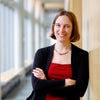
Our Lady of Good Voyages, Boston, MA
Since 1952, Our Lady of Good Voyage has offered Mass to the workers of Boston’s seaport who couldn’t make it to their home congregation on Sunday. This Easter Sunday, the small, brick Catholic port chapel on Seaport Boulevard will open its doors for the last time, as it will soon be razed as part of the ongoing redevelopment of the seaport.
Along with the historic churches, temples and mosques that dot the Boston skyline, sacred spaces like Our Lady of Good Voyages exist around the edges of the city. Photographer Randy Armor, Wellesley College Professor Alice Friedman and I have been documenting these spaces for a project we call Boston’s Hidden Sacred Spaces.
It is easy to overlook these spaces, and as one of them becomes history now seems an appropriate time to notice and consider the ones that remain.
As part of the Hidden Sacred Spaces Project, we have identified more than 80 chapels, meditation spaces and prayer rooms in greater Boston that are housed by organizations with non-explicitly religious purposes. We found them in hospitals, nursing homes, colleges and universities, the port, the airport, public parks, malls, state prisons, cemeteries, and even a local museum.
Well-known architects designed some, while others were created informally as areas to offer a small retreat. Some of the places stand-alone while others are a part of larger buildings. Some of the spaces we found look much as they did when constructed, while many have evolved over time to accommodate people from a range of religious traditions.
At Brandeis University, the original chapels were built in the early 1950s for Protestants, Catholics and Jews. Today there are spaces for Muslim, Hindu, Buddhist and other religions across campus. At Northeastern University, a Sacred Space, a Reflection Room, and an area for ablution, private prayer, and meditation were literally built on the ashes of the university’s traditional Bacon Memorial Chapel that burned in the 1990s.
In some cases, these spaces are used for many religious practices, sometimes side-by-side with each other. At Massachusetts General Hospital, the original chapel was opened in 1941 with support from the Episcopal Diocese of Massachusetts. A Muslim prayer room was opened around the corner from the chapel in 1999. A special niche that indicates the direction of Mecca was added in 2005.
Prison chapels in greater Boston have also expanded to include spaces for people from multiple religious traditions. At the center of Massachusetts Correctional Institution in Concord, a sunken building constructed in the 1970s holds a Catholic chapel, Protestant chapel and Muslim prayer room that are staffed by full and part-time Catholic, Protestant, Muslim and Jewish chaplains.
While formal religious services continue to take place in some of these settings -especially prison chapels - the majority are often used as places of quiet respite these days. As we have traveled around the city we have seen nurses stop into hospital chapels as their shifts change. We have seen family members use them as a quiet place to cry. We saw travelers at Logan sit in darkened pews, with eyes closed and a small suitcase nearby, before they hurried off to find their gates. And we saw many people come through the chapel in the Prudential Center Mall in the midst of a hurried day.
Each of the spaces we found tells a story. Our Lady of Good Voyage was one of several workmen’s chapels built across Boston in the 1950s by Archbishop Cardinal Richard Cushing. The land it was built on was donated to the Catholic Church by the New Haven Railroad Company. Over the years, waterfront workers, seafarers, fishermen and police officers attended services there. In the 1980s, crowds of night workers filled the chapel for midnight masses.
The story of Our Lady of Good Voyages is not over – a new chapel is being built at the corner of Seaport Boulevard and Sleeper Street at the foot of the Evelyn Moakley Bridge and many objects from the first chapel will be moved there.
Religious or not, we encourage Bostonians to notice these spaces, to explore them and learn the stories they tell.
